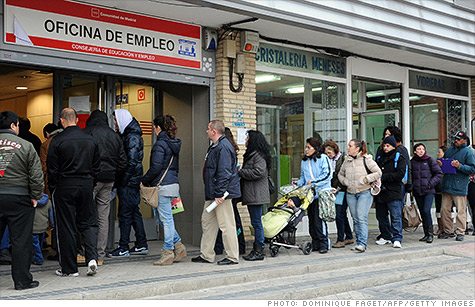Search News

People wait on line at a government unemployment office in a Madrid suburb. Spain had the highest unemployment rate in Europe in April.
NEW YORK (CNNMoney) -- The 17-nation eurozone's unemployment rate reached the highest level since the creation of the common currency 13 years ago, climbing to 11% in April as employers slashed 110,000 jobs.
The unemployment rate in the broader 27-nation area that makes up the European Union rose to 10.3% in April, as employers trimmed 102,000 jobs from their payrolls. That was highest EU unemployment rate on records that go back to 2000.
There were 24.7 million unemployed in the EU in April, of whom 17.4 million were in the eurozone. Both figures are far above the 12.7 million unemployed in the United States, which has a population about 6% less than the eurozone. (CNN Explains: Unemployment rate)
The U.S. May jobs report, also released Friday, showed that U.S. employers added 69,000 jobs, while unemployment ticked up to 8.2%. While both results were much worse than the forecasts of economists surveyed by CNNMoney, who had been expecting 150,000 new jobs to keep unemployment at 8.1%, it was far better than Europe's job picture.
While the unemployment rate in the United States has been falling steadily over the last seven months before Friday's report, it's been climbing across Europe. The unemployment rate for March for the 17 nations that use the euro was also raised to 11% in Friday's jobs report from the initial reading of 10.9%, while the March reading for the EU was 10.2%.
The ongoing European sovereign debt crisis is getting most of the blame for the employer job cuts. It has cut into lending by banks, reduced government employment as part of austerity plans to deal with rising debt, and led to private-sector job losses due to decreased customer demand.
Both the EU and eurozone suffered from zero economic growth in the first quarter as both teetered on the brink of a recession. Eleven nations have suffered a decline in their GDP for at least the last two quarters, which is the common definition of a recession.
The worst unemployment problems were in Spain, where the jobless rate hit 24.3%. Greek unemployment hit 21.7% in February, the most recent month for which figures are available.
Greece is at risk defaulting on its sovereign debt, especially if a European bailout deal collapses as a result of elections now set for June 17. Such a move could force it out of the eurozone. Spain is dealing with a crisis in its banking system and could need a European bailout of its own.
The unemployment problem is especially severe for young workers across Europe, as 22.4% of those age 24 or younger were jobless in the EU in April. More than half of the young workers without jobs in Spain and Greece. ![]()
| Overnight Avg Rate | Latest | Change | Last Week |
|---|---|---|---|
| 30 yr fixed | 3.80% | 3.88% | |
| 15 yr fixed | 3.20% | 3.23% | |
| 5/1 ARM | 3.84% | 3.88% | |
| 30 yr refi | 3.82% | 3.93% | |
| 15 yr refi | 3.20% | 3.23% |
Today's featured rates:
| Latest Report | Next Update |
|---|---|
| Home prices | Aug 28 |
| Consumer confidence | Aug 28 |
| GDP | Aug 29 |
| Manufacturing (ISM) | Sept 4 |
| Jobs | Sept 7 |
| Inflation (CPI) | Sept 14 |
| Retail sales | Sept 14 |